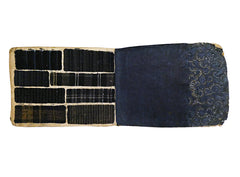A Nineteenth Century Shimacho: Hand Made Album of a Family's Home Weaving
mid to late nineteenth century
when closed: 8" x 5 1/2" x 1", 20 cm x 14 cm x 2.5 cm
11 pages (double sided) of samples and ten blank pages showing hand writing.
Shimacho means, literally, "stripe album." The small, cotton swatches contained within it are usually striped cotton, or some variation on striped cotton.
A shimacho is said to be an album of home weaving that a bride takes from her family home when she's married, leaves her family and begins her life in the home of her new husband's family. Most likely this is in part true, however it is more likely that a shimacho has a broader beginning and a less prosaic life. It is not unthinkable that a sliver of a neighbor's weaving found its way into a shimacho, or some such thing.
Often the striped cloth in a shimacho shows narrow stripes or small checks in dark colors.
The reason for this is that in old Japan there were sumptuary laws which dictated how a person could dress and how they should conduct other aspects of their lives. Most of the population was only allowed to wear dark, somber colors and cloth showing very little pattern, if any. Therefore, shimacho usually reflect this societal dictate by showing scraps of hand woven cotton in dark colors.
This one contains many and lovely pieces of striped and checked hand loomed cotton cloth. The fact that there is scant, if any, evidence of synthetic dyes on these swatches indicates the cloth was probably woven in the mid-to-late nineteenth century.
The swatches were glued with rice paste into a hand bound book done in a traditional, Japanese binding technique.
Please note the evidence of indigo dyed, gold printed paper that once covered the front and back of this book before time and wear have shredded it from the surface.
A wonderful thing to own.
Highly recommended.


